Cal Poly to Lead Development of California’s New Urban Forestry Strategic Plan

Cal Poly has been awarded the contract to spearhead the creation of California’s new strategic plan for urban forestry, a major initiative in partnership with Cal Fire. Driven by Assembly Bill 2251, the project aims to boost canopy cover by 10% by 2035, addressing climate change, fostering healthier communities and enhancing equity in green space access.

“This strategic plan gives Cal Poly students a direct path to using their data to solve real-world problems,” said Jenn Yost, biological sciences professor and lead on the project. “We have some of the best urban forestry datasets to create this plan.”
California faces growing challenges from climate change, with disadvantaged communities disproportionately affected by extreme heat and limited access to shade. Increasing canopy cover in these areas will mitigate rising temperatures, improve air quality and provide critical ecosystem services such as carbon capture and stormwater management.
Cal Poly’s role in this effort builds on its Urban Forest Ecosystems Institute (UFEI), which has become a central authority in urban forestry. The institute’s innovative tools — such as SelecTree, an online resource used by over 250,000 people each month — have supported urban forestry management statewide.
“California is the most urbanized state in the country, yet it has the lowest per capita canopy cover,” said biological sciences professor Matt Ritter, UFEI director. “This initiative is a critical step toward reversing that trend.”
UFEI’s cutting-edge mapping techniques have already identified 40 million trees across California using a neural network powered by more than 8 million data points. The insights generated will inform policies and strategies to expand canopy cover in underserved areas, ensuring equitable access to the benefits of urban forests.

The California Strategic Plan for Urban Forestry (CASP) will incorporate extensive data to:
- Measure canopy coverage statewide to identify areas for improvement;
- Prioritize biodiversity to ensure resilience against disease and environmental stressors;
- Equip cities with goals and actionable strategies to expand tree canopy in disadvantaged areas; and
- Engage stakeholders to ensure effective implementation and community impact.
“At its core, the initiative shows the groundbreaking power of data and collaboration,” said Jonathan Ventura, a computer science professor who played a key role in mapping trees. “It’s not just about finding the right algorithm; it’s what the data tells us and why it matters.”
Throughout the yearlong effort, Cal Poly’s team, led by Yost, Ritter and their collaborators, will coordinate with tribal nations, nonprofits, local governments and tree professionals. They will also solicit input from urban forestry stakeholders to ensure a comprehensive and inclusive plan.
By June 2025, the team will deliver California’s strategic urban forestry plan to the state legislature, providing a detailed roadmap for increasing canopy cover and fostering thriving, resilient communities statewide.
For more information or to participate in the feedback process, please contact Yost at jyost@calpoly.edu.
Want more Learn by Doing stories in your life? Sign up for our monthly newsletter, the Cal Poly News Recap!




